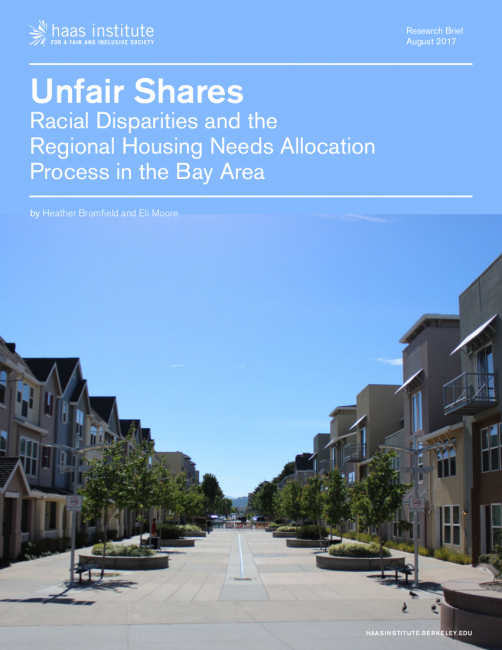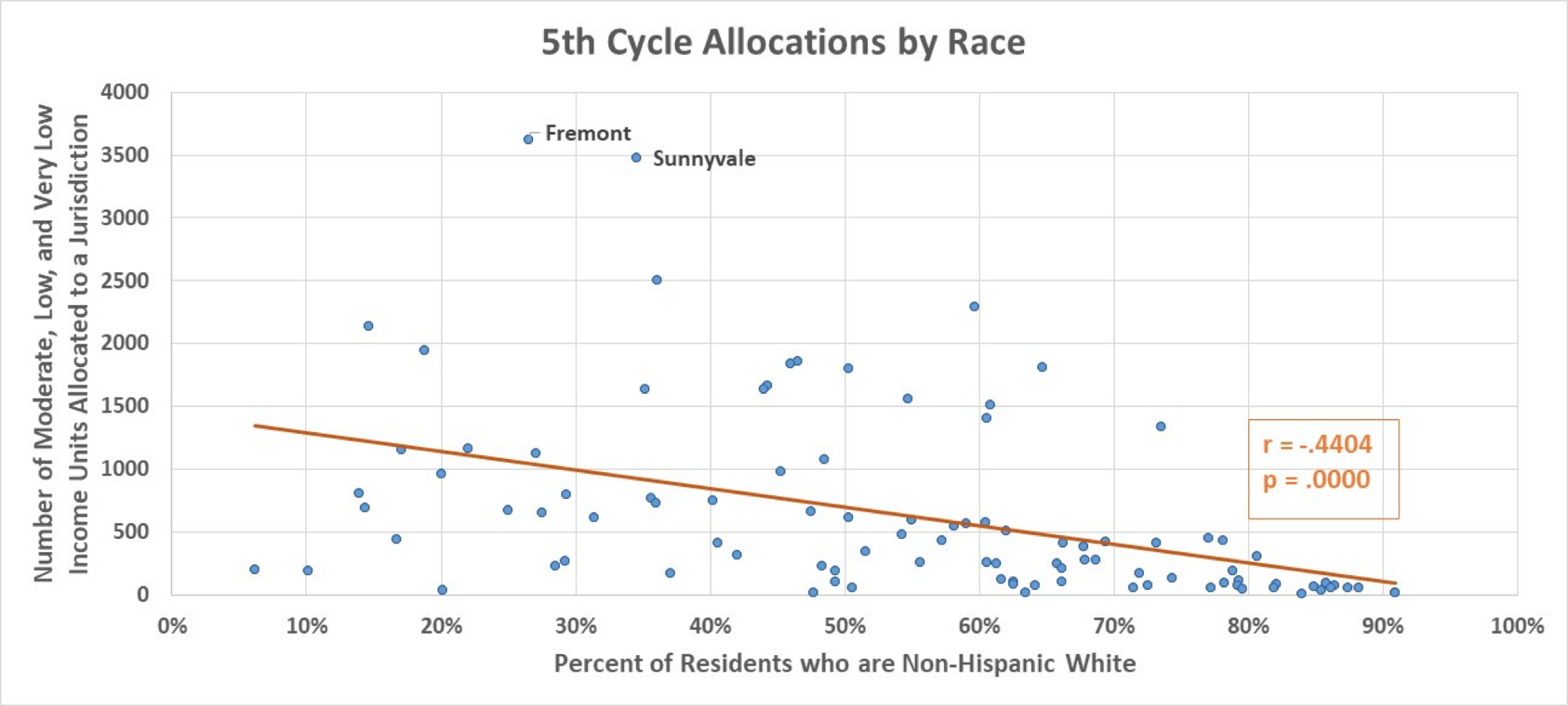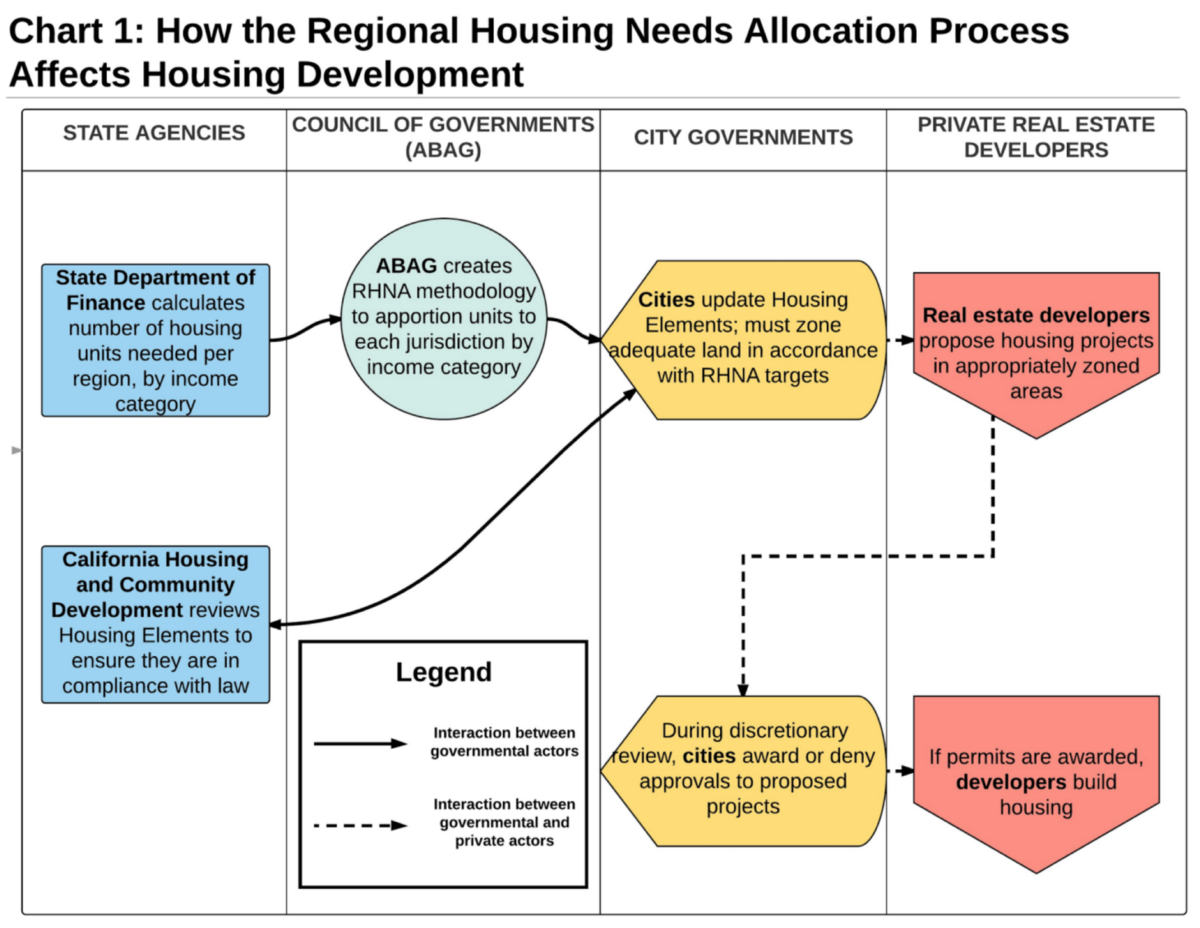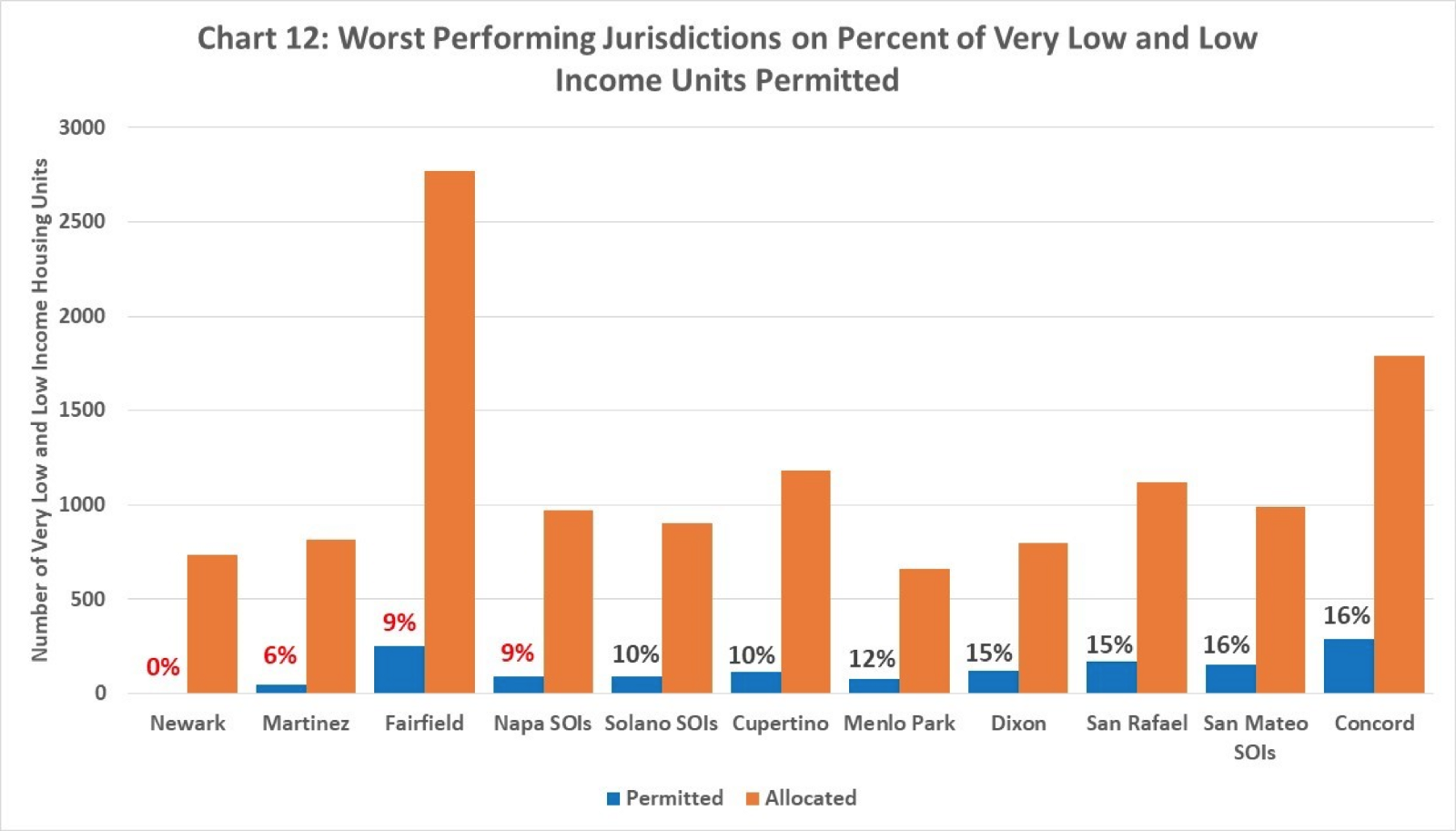By Heather Bromfield and Eli Moore
California has been in the national headlines in recent months because of its bafflingly high housing costs, which are unaffordable even to some of the highest income earners. In the Bay Area, where a booming tech industry has sparked robust economic growth alongside yet another spike in the region’s population, the housing problem has become particularly acute, with 31% percent of households currently cost-burdened and a housing supply deficit of 1.5 million units.But it’s no secret that some jurisdictions in the San Francisco Bay Area — especially wealthy, suburban jurisdictions — are highly opposed to new housing development, and often justify this position on the grounds that they want to preserve the character of their communities. The term “NIMBY” (“Not In My Backyard”) has become part of the popular vocabulary, as anti-growth activists have been able to capitalize on the great deal of autonomy that American cities have. Even in the face of human tragedies, some NIMBYs use shockingly frivolous arguments as to why new housing should go somewhere else. More recently, the NIMBYs have even sparked the creation of an oppositional “YIMBY” (“Yes In My Backyard”) movement that is organizing to encourage more housing.
To address the fact that local control has historically been used to exclude low-income, and especially black and brown residents, from residing in more affluent areas with better services, and to ensure that there is a sufficient supply of housing to prevent major housing shortfalls, states like California have adopted ‘fair share’ housing policies to establish housing goals for each local jurisdiction. In California the housing goals for each jurisdiction are known as “allocations,” and state law requires jurisdictions to make zoning plans that satisfy their allocation numbers.
However, despite there being “fair share” policy in place in California, there are serious problems with the policy’s implementation at multiple levels of government. The Bay Area region as a whole has fallen far short of meeting its goals year after year without consequence, even while renters and owners have suffered from record-breaking cost burdens, and homelessness has become increasingly visible in Bay Area cities. [1]
Further undermining the idea of a “fair share,” however, is the fact that according to our analysis, the housing shares have let communities with large non-Hispanic white populations “off the hook” for housing development. The study we released last month, Unfair Shares, found that local governments in the Bay Area with higher percentages of white residents were more likely to have received lower allocations of moderate and lower income housing. Even after we controlled for population size, the effect remained. Moreover, city racial composition was more strongly correlated with allocation size than median income. This finding — that the housing goals themselves are inequitable — poses a problem for analyzing the housing units permitted: if the goals are inequitable, then judging jurisdictions by how well they have met those goals is akin to using a broken thermometer to compare temperatures.
Our findings are important because they suggest that white communities are still able to engage in “exclusionary zoning,” a term which refers to a range of zoning practices that increase the cost of producing housing, such as mandating large minimum lot sizes or imposing tight density restrictions. Exclusionary zoning has the effect of limiting the types of households who can afford housing in these jurisdictions to those that are affluent. Because intergenerational wealth is so highly associated with race, for reasons discussed extensively in a recent BLOCK blog post by Richard Rothstein, this also results in excluding people of color from these communities. While racial exclusion is rarely explicit in Bay Area city planning discussions, the effect of these practices hearkens back to earlier decades of explicit means of maintaining white, racially exclusive communities. Furthermore, we have no reason to believe that there was any intentional action taken to give cities with more white residents smaller housing goals; rather, this was an unintended — but avoidable — consequence of the strategy chosen to allocate regionwide housing goals. The chart below shows what housing goals were in the 5th RHNA Cycle (which spanned the years 2015 to 2023).
Unfair Shares shines light on an aspect of housing planning and production that has flown under the radar for many housing advocates in California. Officially known as the Regional Housing Needs Assessment (RHNA) process, the procedure for determining cities’ allocations begins with regional authorities (formally known as “councils of governments,” or COGs) using household growth projections from the California State Department of Finance to determine where housing should be located across the region. Each jurisdiction receives a housing production goal for very low income, low income, moderate income, and above moderate income housing units. Every eight years a new methodology is developed to determine what each jurisdiction’s housing allocation will be.
Our research revealed some of the unintended consequences of failing to explicitly consider social equity while dealing with jurisdictions’ antagonism toward affordable housing. For example, American Canyon, where 29% of households are non-Hispanic white, was allocated 228 moderate and lower income new units; while Orinda, which has a slightly larger population as well as a BART station, was allocated only 185 moderate and lower income units. Orinda is 79% non-Hispanic white. Mill Valley, another area that is 86% non-Hispanic white, was allocated just 91 moderate and lower income housing units, while Pinole, 37% non-Hispanic white, was allocated 171 moderate and lower income housing units.
There is a technical explanation for some of the discrepancies: ABAG/MTC allocated about 70% of housing units to areas with “Priority Development Areas” (PDAs), which are “served by public transit and have been identified as appropriate for additional, compact development.” The PDA’s are part of the state’s recent climate change mitigation legislation, which seeks to better plan land use, transportation, and housing in order to reduce greenhouse gases. However, PDA designations occur through a political process, rather than a research-driven process. Jurisdictions opt in to have PDAs designated, rather than having objective criteria determine where these zones should be located. Cities with strong anti-growth political forces can therefore opt not to have PDAs, or to minimize the geographic size of PDAs, in their efforts to limit the amount of future housing growth that they are obligated to produce via the RHNA process.
PDAs have very similar criteria to another ABAG/MTC-designated transit zone called Transit Priority Project corridors, or TPPs. Both are transit-served corridors that can accommodate dense growth. But TPPs are designated objectively, while PDAs are created voluntarily by a local jurisdiction. PDAs result in higher housing allocations, while TPPs do not. The reliance on a zoning designation that is voluntary for local jurisdictions has undermined regional goals for reducing commute distances and greenhouse gases.
The RHNA process is important because California requires cities to ensure that sufficient land is zoned to accommodate the amount of housing specified by the COG (the regional government body). Cities must identify the individual parcels where the housing units could be constructed under favorable market conditions. As a result, when cities receive low allocations, fewer of their areas needs to be zoned to support housing development. If the land is not zoned for a large number of affordable units and a housing developer proposes a project that requires a variance, planning departments have wide latitude in granting or denying building permits, and there is presently no state statute that requires jurisdictions to grant permits for any given number of housing units per year. [2]
In using PDAs as the primary criterion for determining housing goals for cities, we argue that ABAG/MTC may have also actually increased the need for personal vehicle transportation. In affluent, white communities where low-income people are already working, there is a dire need for low-income housing, but if people are unable to live in these areas they must commute by car. As a result, it’s entirely plausible that the methodology used in the current RHNA period may have actually increased greenhouse gas emissions.
Outside of the problematic way in which housing goals have been set, there is an additional critical problem: housing goals are unenforced, and cities are not reaching these housing goals virtually across the board. The following chart shows how poorly the region as a whole has been performing in terms of meeting its housing goals by income category.
It’s difficult to know whether a more equitable housing allocation process would result in a higher percentage of units permitted, in light of the formidable resistance that anti-growth jurisdictions put up when housing projects are proposed. What is clear now, however, is that as a region the Bay Area is certainly falling short of its housing goals. The region only permitted an average of 29% [3] of needed moderate-income, low-income and very low-income housing units respectively between 2007 and 2014, while it permitted 98.5% of the needed above-moderate income housing.
However, certain cities performed far better than others in reaching their housing goals. We therefore set out to determine whether there were any correlations between the demographic attributes of these places and the percentage of their housing goals that they permitted. We were particularly interested in studying how race may or may not be a factor in determining how housing goals are met, because of the aforementioned lengthy history of resistance to racial and economic de-segregation, and current use of thinly- (and not-so-thinly-) veiled claims that lower income housing would ‘bring in a bad element’. We analyzed the racial composition and median income (separately, and also together) of each jurisdiction to see how it correlated with their units permitted. But ultimately, we found that there was no statistical relationship.
We found that for cities with more than 500 low income and very low income units permitted between 1999–2014, there was no indication that a cities’ position in the Bay Area (i.e. Inland, Bayside, or Delta) was related to their performance relative to housing targets, which might have been expected given the different real estate dynamics in different parts of the region. This suggests that factors within jurisdictions’ control — such as zoning, land use, and municipal-level funding for affordable housing — are tremendously important in incentivizing or disincentivizing both housing development proposals and the overall number of permits issued, and may be just as crucial to cities’ housing performance as factors outside of cities’ control, including market dynamics.
Our research provides a constructive critique of current efforts to integrate land use, transportation, and housing. Thus far, the agencies in the Bay Area have indicated that they intend to maintain the status quo in terms of concentrating housing development in a handful of cities with high levels of projected job growth. We agree that it makes sense to concentrate housing development in areas with many jobs, but it’s important to highlight that there are many cities that already have many workers who must commute to their jobs every day in the absence of appropriately-priced housing options near their places of employment.
This is obviously an important contributor to greenhouse gas emissions. To address this, ABAG/MTC will need to consider the existing housing/transportation fit in addition to projected job growth. Finally, ABAG/MTC should explicitly consider Fair Housing considerations in developing its new methodologies. This would mean breaking down barriers to opportunity in jurisdictions that historically eschewed low and moderate income housing, ensuring that these parts of the region with high-performing schools, access to jobs, and high environmental quality are not the exclusive bastion of affluent white people. As regions across the country develop and refine their own plans to mitigate climate change through regional planning, they would be wise to apply these recommendations as well. Our findings are also relevant to other states considering fair share housing policies, and California’s own process of updating the RHNA methodology, which will begin in 2018.
Overall, the unintended consequences of California’s fair share regulation has meant that local control has superseded region-wide housing needs, highlighting the crucial role of implementation of fair share laws nationwide. White, affluent communities in California have not pulled their weight in producing housing, to the obvious detriment of people of color, low-income households, and the increasing numbers of homeless people in the area. While these jurisdictions wave the flag of “local control,” they continue to benefit from a booming economy and from the inflated property values that come with housing scarcity. Regional agencies and state authorities therefore need to take bolder action in their interactions with these cities, incorporate Fair Housing considerations when allocating housing units, and impose real consequences when they will not cooperate.
[1] For example, Oakland’s homeless population increased by 25% between 2015 and 2017, and the city has responded by providing limited health and hygiene services to encampments. Similarly, Alameda County saw a 30% increase in homelessness over the same period. See “Homeless Camps Become Entrenched in Oakland,” and “Alameda County Homeless Point-in-Time Count and Survey.”
[2] While Transit Priority Project corridors are subjected to CEQA streamlining (meaning that proposed housing projects which conform with the existing zoning standards are exempt from the threat of a costly and lengthy environmental review process), jurisdictions have no obligation to ensure that their TPP areas are zoned for high-density housing that can support higher levels of affordability; cities therefore face no real requirements to approve low- or moderate-income housing in TPPs.
[3] 28.4 percent for moderate income, 25.9% for low income, and 29.2% for very low income.
This article originally appeared on Medium on October 5, 2017.
Editor's note: The ideas expressed in this blog post are not necessarily those of the Haas Institute or UC Berkeley, but belong to the authors.










